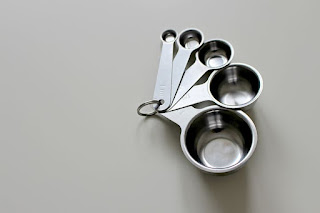Have you been stuck when cooking, trying to measure a 3/4 cup ingredients without any clue? In this blog post I have combined the easiest ways to measure 3/4 cups with measuring cups.
This cooking tips will help maximize the use of your time when cooking, and also teach you the easy way to measure ingredients from dry - flour, sugar, salt to liquid - water or oil.
How to measure 3/4 on a measuring cup
Before going deep into this short lecture, it's best to note some things, and some of them allows us to even know what we are dealing with, for example knowing what is 3/4 on a measuring cup.
What is 3/4 on a measuring cup
All measuring cups usually come in different sizes, and they do have markings indicating different volumes such as 1 cup, 1/2 cup, 1/3 cup, 1/4 cup, and so on.
So, to speak on what is 3/4 on a measuring cup, know that a measuring cup with a 3/4 mark indicates a volume measurement of 3/4 of a cup. This means that when the measuring cup is filled up to the 3/4 mark with a liquid or dry ingredient, it contains 3/4 of a cup or 12 tablespoons or 36 teaspoons.
Now for the moment of truth...
How do I measure 3/4 cups with measuring cup?
To measure 3/4 cups using measuring cups, you can follow these steps:
- Start with a 1/4 cup measuring cup.
- Fill it with the ingredient you want to measure until it is level with the rim.
- Pour the contents of the 1/4 cup measuring cup into a measuring cup with a 1/2 cup capacity.
- Repeat the process, filling the 1/4 cup measuring cup again with the same ingredient and leveling it off.
- Pour the contents of the 1/4 cup measuring cup into the measuring cup with the 1/2 cup capacity.
- Add up the amount of the ingredient in both the 1/2 cup and 1/4 cup measuring cups to get a total of 3/4 cup
How to measure 3/4 cups with dry measuring cups
The basic ingredients we make use of in the kitchen are categorized into two, that's the liquid and the dry ingredients - I'm talking about those that need measurements, you'll mostly make use of the two type of ingredients when cooking foods like the Nigerian jollof rice or even other types like the Mexican microwave rice.
Here is how to measure 3/4 cups with dry measuring cups
- Take a 1/2 cup measuring cup and fill it up to the top with the dry ingredient you want to measure.
- Use a flat edge, like a knife or spatula, to level off the top of the measuring cup.
- Take a 1/4 cup measuring cup and fill it up to the top with the same dry ingredient.
- Use a flat edge to level off the top of the measuring cup.
- Add the contents of the 1/4 cup measuring cup to the 1/2 cup measuring cup.
- Stir or shake the measuring cup gently to ensure that the ingredient is well-mixed.
Tip: when measuring, it's important to use dry measuring cups rather than those for liquid, because the two types of cups are calibrated differently.
How to make 3/4 cup without measuring cups
Do you find yourself cooking, and you happen to need to quickly measure some ingredients, but you don't have any measuring cups? Here's a quick way to measure 3/4 without measuring cups.
- Use a tablespoon: There are 16 tablespoons in one cup, so 3/4 cup is equivalent to 12 tablespoons. If you have a tablespoon, you can measure out 12 level tablespoons of the ingredient to get 3/4 cup.
- Use a quarter cup and a tablespoon: Since there are 4 tablespoons in 1/4 cup, you can use a 1/4 cup measuring cup and a tablespoon to measure 3/4 cup. Measure out 1/4 cup of the ingredient and then add 3 tablespoons to reach a total of 3/4 cup.
- Use a liquid measuring cup: If you have a liquid measuring cup with volume markings, you can use it to measure 3/4 cup of dry ingredients. Fill the measuring cup with the ingredient up to the 3/4 cup mark.
- Use your hand: If you're comfortable estimating measurements by hand, you can use your hand to estimate 3/4 cup. For example, a handful of dry ingredients or a scoop with your hand may roughly equate to 3/4 cup.
Tip: Note that these methods of measurement may not be accurate unlike the previous mentioned ways, so the amount of the ingredient may be slightly different than the recipe calls for. But, not to worry, there are still some form of accuracy in these procedures, and they can be very helpful.







No comments:
Post a Comment
Tell me what you think about this recipe